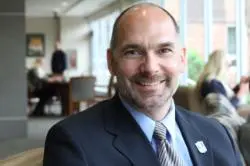NWHSU dean helps to push for hospital massage standards
Rob Karwath for NWHSU | May 23, 2018
Dale Healey, Dean of the College of Health & Wellness at NWHSU, is part of a national team developing universally accepted competency standards for massage in hospitals.
Across the country, health experts applaud efforts to bring more therapeutic massage into hospitals as a helpful treatment for patients.
But experts also realize that they need to establish standards to help hospitals and massage therapists understand what constitutes the best use of and performance of massage in hospitals, as well as how to hire and train for hospital massage jobs.
Dale Healey, Dean of the College of Health & Wellness at Northwestern Health Sciences University, is part of a national team developing universally accepted competency standards for massage in hospitals. The project is an initiative of the Academic Collaborative for Integrative Health. Healey is a member of the group’s board of directors. Work on the project is wrapping up, and the group is sharing its recommendations with the health-care industry.
The strong push for—and interest in—more therapeutic massage in hospitals has created the need for standards, Healey says. As it turns out, massage in hospitals is much different from what most consider the traditional practice of massage.
“Most massage schools have traditionally trained massage therapists for work in what we’ve come to know as the standard setting,” Healey says. “It’s a clinic or a practice with a small room, dim lights and ambulatory patients.”
But, he adds, “The hospital setting calls for something that often is quite different. Massage typically happens at the bedside, not on a traditional massage table. The body mechanics are much different. And the biggest difference is often the patients themselves. In hospitals, massage therapists often work with acutely ill patients. Therapists are not giving the typical 60- or 30-minute full body massage. Their work is much more targeted. They often are not treating diseases but instead some of the things that go along with patients being in a hospital, including anxiety, pain and stress.”
Add in that hospital massage therapists also work as part of integrated health-care teams, with the many protocols and communication needs of a large institution, and the work of massage therapists in hospitals can look radically different.
Competency standards are needed not only to ensure the best care for patients but also to make clear that hospitals have an understanding of the skills they seek—and that massage therapists know what it means to work in hospitals.
“A really big thing is the emotional component for the therapist,” Healey says. “In the hospital, they may be caring for someone in a very bad state, maybe someone who is dying. That can have a profound effect on the therapist. We have to make sure that they are prepared. Most schools aren’t training for that sufficiently right now. And hospitals are telling us that they don’t know what to look for or ask of their therapists.”
“The goal is to get a set of standards so everyone understands the needs and expectations better,” he says, “and so outcomes are better for patients.”
